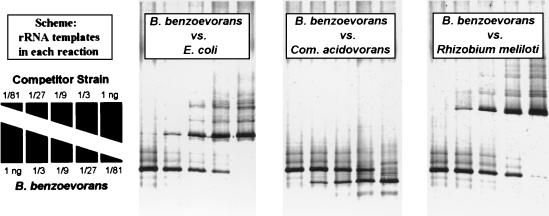FIG. 1.
Competitive RT-PCR performed with rRNA standards from different bacterial taxa. The scheme on the left shows the order of rRNA input. In the third of the five reactions equal amounts of the two competitor rRNAs are present. This ratio is also reflected by band intensities after separation of the amplicons by TGGE and detection by silver staining (2 μl of RT-PCR product per lane). The faint bands accompanying the main bands were RT-PCR side products and were not included in the quantitative analysis. We used more RT-PCR product than necessary to visualize traces of the out-competed sequence. However, the highly sensitive silver staining method also detected some RT-PCR side products, most likely side products representing a DNA polymerization bias.

